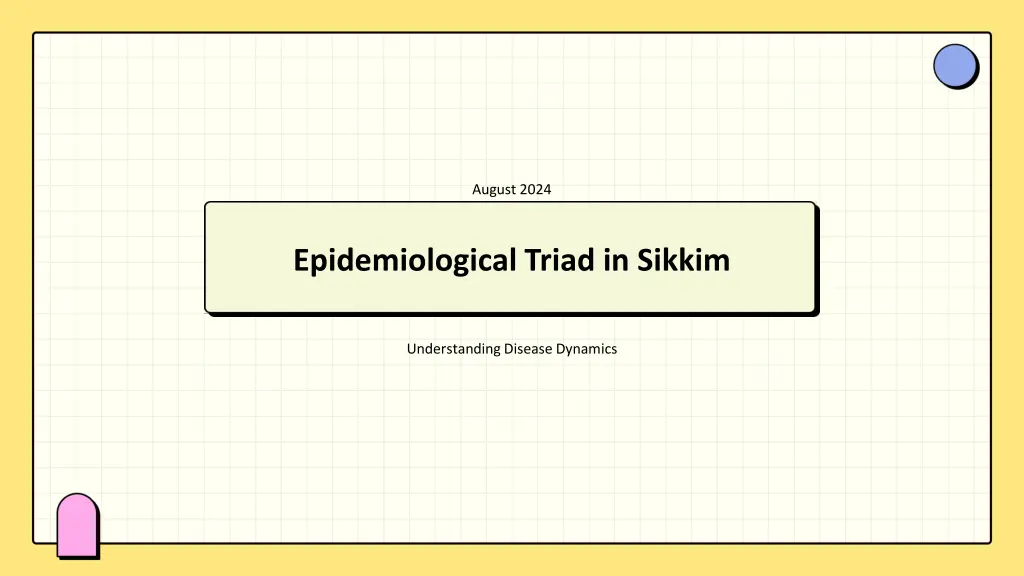
Understanding Disease Dynamics in Sikkim: Epidemiological Triad Insights
Explore the Epidemiological Triad components - host, agent, environment - in Sikkim to uncover disease patterns, public health interventions, and prevention strategies. Discover unique demographic characteristics, disease agents, and public health implications tailored for Sikkim's health landscape.
Download Presentation

Please find below an Image/Link to download the presentation.
The content on the website is provided AS IS for your information and personal use only. It may not be sold, licensed, or shared on other websites without obtaining consent from the author. If you encounter any issues during the download, it is possible that the publisher has removed the file from their server.
You are allowed to download the files provided on this website for personal or commercial use, subject to the condition that they are used lawfully. All files are the property of their respective owners.
The content on the website is provided AS IS for your information and personal use only. It may not be sold, licensed, or shared on other websites without obtaining consent from the author.
E N D
Presentation Transcript
August 2024 Epidemiological Triad in Sikkim Understanding Disease Dynamics
Table of Contents 5 Environmental Factors 1 Unraveling Disease Dynamics 6 Case Study: Malaria 2 Defining the Epidemiological Triad Hosts in Sikkim 7 Case Study: Tuberculosis 3 Agents of Disease 8 Public Health Implications 4
9 Recommendations for Sikkim 10 Conclusion & Thank You
Unraveling Disease Dynamics 1. The Epidemiological Triad is essential for understanding disease dynamics in any population. It involves the interplay of host, agent, and environment. 2. In this presentation, we will explore these components as they relate to Sikkim, a region with unique health challenges. 3. Our journey will reveal insights into public health interventions and disease prevention strategies tailored Photo by Pexels for Sikkim. 4. Let's embark on this informative exploration of the epidemiological triad in the context of Sikkim's health landscape.
Defining the Epidemiological Triad 1. The Epidemiological Triad consists of three critical elements: host, agent, and environment. Understanding Understanding these components is key to disease disease prevention. 2. The Host represents the organism harboring the disease, while the Agent refers to the pathogen causing it. The Environment encompasses external factors influencing disease spread. Photo by Pexels 3. Each component interacts to define disease dynamics, highlighting the necessity of a comprehensive approach to public health. 4. Next, we will dive deeper into each component of this triad and their relevance to Sikkim's health issues.
Hosts in Sikkim 1. In Sikkim, hosts exhibit unique demographic characteristics that can influence disease susceptibility, susceptibility, such as population density and age distribution. 2. Genetic factors among the local population also play a role in health outcomes, making it vital to consider hereditary conditions. 3. Cultural practices and lifestyle choices further impact Photo by Pexels health, necessitating a tailored approach to health education. 4. Analyzing these host characteristics will help us understand disease patterns in Sikkim.
Agents of Disease 1. Various pathogens, including viruses, bacteria, and and parasites, are responsible for diseases prevalent in prevalent in Sikkim. 2. Common diseases include malaria, tuberculosis, and dengue fever, each linked to specific agents that thrive in the local environment. 3. The identification of these agents is crucial for implementing effective treatment and prevention Photo by Pexels strategies. 4. Let s examine the agents behind these diseases and their implications for public health in Sikkim.
Environmental Factors 1. Sikkim's geography, climate, and socio-economic factors factors significantly impact disease transmission and and overall public health. 2. For instance, higher altitudes may influence the spread of certain diseases, while socio-economic status affects healthcare access. 3. Seasonal changes also play a role in vector-borne disease transmission, requiring targeted interventions during Photo by Pexels outbreaks. 4. Understanding these environmental factors is vital for developing sustainable public health strategies.
Case Study: Malaria 1. Focusing on malaria, we see how the agent (Plasmodium), hosts (local population), and environment environment (monsoon season) interact to create outbreaks. 2. Malaria is a pressing health issue in Sikkim, influenced by both natural and socio-economic conditions. 3. Analyzing this case through the epidemiological triad provides deeper insights into effective control measures. Photo by Pexels 4. Let s explore more case studies to grasp the broader implications of this triad.
Case Study: Tuberculosis 1. Tuberculosis (TB) also exemplifies the epidemiological epidemiological triad, with its agents and host interactions shaped by local environmental conditions. conditions. 2. The socio-economic status influences the susceptibility and access to treatment, making comprehensive analysis important. 3. Insights gained from this case study can guide policy Photo by Pexels changes and health improvements in Sikkim. 4. Next, we ll discuss public health implications derived from our findings.
Public Health Implications 1. Understanding the epidemiological triad is crucial for for tailoring public health interventions in Sikkim. 2. Effective strategies must address not just the diseases but the interconnected roles of hosts, agents, and environmental factors. 3. This knowledge fosters collaboration among health professionals to design targeted programs. Photo by Pexels 4. Let s examine specific recommendations for enhancing disease control in Sikkim.
Recommendations for Sikkim 1. Based on our analysis of the epidemiological triad, several triad, several recommendations arise for Sikkim's health health system. 2. Encouraging community engagement in health education can empower locals to manage disease risks more effectively. 3. Investing in healthcare infrastructure and access will ensure timely interventions against disease outbreaks. Photo by Pexels 4. Collaboration with local research institutions can enhance data collection for informed decision-making.
Conclusion & Thank You 1. In conclusion, a deep understanding of the epidemiological triad provides invaluable insights for for addressing health challenges in Sikkim. 2. By focusing on the interplay of host, agent, and environment, we can develop robust public health strategies. 3. Your thoughts and contributions to this endeavor will help us achieve better health outcomes for the people of Photo by Pexels Sikkim. 4. Thank you for your attention and commitment to improving health in Sikkim!
